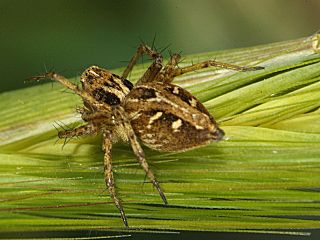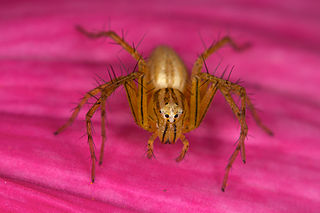
Lynx spider (Oxyopidae) is a family of araneomorph spiders first described by Tamerlan Thorell in 1870. Most species make little use of webs, instead spending their lives as hunting spiders on plants. Many species frequent flowers in particular, ambushing pollinators, much as crab spiders do. They tend to tolerate members of their own species more than most spiders do, and at least one species has been identified as exhibiting social behaviour.
Oxyopes cornutus is a species of lynx spider documented first by F. O. Pickard-Cambridge in 1902, and found in Mexico.
Oxyopes lepidus is a species of lynx spider found in India.
Oxyopes takobius is a species of spiders in the genus Oxyopes of the lynx spider family, Oxyopidae. The species was first described in 1969, and is found from Central Asia to China. Its venom contains a peptide toxin called oxyopinin, which was discovered in 2002.

Oxyopes lineatus is a species of spider in the family Oxyopidae, the so-called lynx spiders.

Oxyopes macilentus, sometimes known as the lean lynx spider, is a species of lynx spiders from East Asia, South Asia, Southeast Asia, and northern Australia. They are active predators, hunting invertebrates among vegetation. They are especially common in grassy areas and rice fields. Their bodies are characteristically long and thin, about four times as long as it is wide. Their body color ranges from pale white to yellow, orange, or green; with a pattern of black, orange, and white longitudinal lines. Females have a maximum body length of 10 mm (0.39 in), while males grow to 9 mm (0.35 in).
Oxyopes ceylonicus, is a species of spider of the genus Oxyopes. It is endemic to Sri Lanka.
Oxyopes daksina, is a species of spider of the genus Oxyopes. It is found in China and Sri Lanka.
Oxyopes hindostanicus is a species of spider of the genus Oxyopes. It is found in India, Pakistan and Sri Lanka.
Oxyopes juvencus is a species of spider of the genus Oxyopes. It is endemic to Sri Lanka.
Oxyopes nilgiricus is a species of spider of the genus Oxyopes. It is endemic to Sri Lanka.
Oxyopes rufisternis is a species of spider of the genus Oxyopes. It is endemic to Sri Lanka.

Oxyopes heterophthalmus is a lynx spider from the family Oxyopidae, it is the type species of the genus Oxyopes and was described by Pierre André Latreille in 1804, it has a Palearctic distribution.

Oxyopes elegans is a species of lynx spiders found in Queensland and New South Wales.
Oxyopes occidens is a species of lynx spider in the family Oxyopidae. It is found in the United States and Mexico.
Oxyopes apollo, the jumping lynx, is a species of lynx spider in the family Oxyopidae. It is found in the United States and Mexico.

Oxyopes tridens is a species of lynx spider in the family Oxyopidae. It is found in the United States and Mexico.
Oxyopes acleistus is a species of lynx spider in the family Oxyopidae. It is found in the United States and Mexico.

Oxyopes aglossus is a species of lynx spider in the family Oxyopidae. It is found in the United States.

Oxyopes scalaris, the western lynx spider, is a species of lynx spider in the family Oxyopidae. It is found in North America. A study based in Washington found that this species reaches adulthood and is most active in spring and early summer. They are considered beneficial in orchards.








